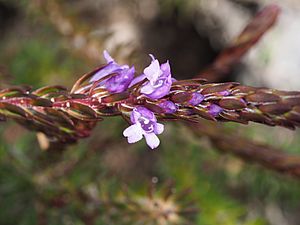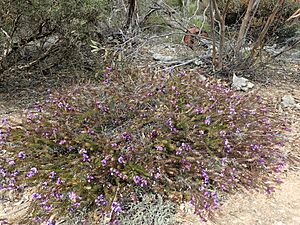Eremophila densifolia facts for kids
Quick facts for kids Eremophila densifolia |
|
|---|---|
 |
|
| Eremophila densifolia densifolia leaves and flowers | |
| Scientific classification | |
| Genus: |
Eremophila (plant)
|
| Species: |
densifolia
|
| Synonyms | |
Eremophila densifolia is a beautiful flowering plant that belongs to the figwort family. You can only find this plant in the south-west part of Western Australia. It usually grows as a low, spreading bush with lots of leaves packed together and pretty lilac to purple flowers.
Contents
What it Looks Like
Eremophila densifolia is often a low, spreading shrub. It typically grows about 0.3 to 0.5 meters (1 to 1.6 feet) tall and around 0.7 meters (2.3 feet) wide. Some types can grow taller, up to 1.8 meters (5.9 feet) high.
Its leaves are packed closely together and overlap. They are shaped like a line or a spear, usually 6 to 18 millimeters (0.2 to 0.7 inches) long and 1 to 2.5 millimeters (0.04 to 0.1 inches) wide. The leaves are usually smooth (without hairs) and can be green or reddish-brown.
The flowers grow one by one where the leaves meet the stem. Each flower has 5 green, spear-shaped sepals that are 3.5 to 6.5 millimeters (0.1 to 0.3 inches) long. The petals are 9.5 to 14 millimeters (0.4 to 0.6 inches) long and are joined at the bottom to form a tube.
The outside of the flower tube is purple or lilac. The inside is white with purple spots. The petal tube is mostly smooth, but the bottom petal and the inside of the tube have long, soft hairs. The 4 stamens (the parts that make pollen) are hidden inside the petal tube. After flowering, which happens at different times for different types, the plant produces small, dry, oval-shaped fruits that are 2.5 to 3 millimeters (0.1 inches) long.

Plant Names and Types
The plant Eremophila densifolia was first officially described by Ferdinand von Mueller in 1861. He published his description in a book called Fragmenta phytographiae Australiae.
The second part of its name, densifolia, comes from two Latin words: densus, meaning "thick" or "close," and folia, meaning "leaves." This name describes how the plant's leaves are packed together.
There are four different types (called subspecies) of Eremophila densifolia:
- Eremophila densifolia subsp. densifolia: This type is a bushy shrub that spreads low to the ground. Its leaves and the outside of its flowers are smooth. It flowers from September to December.
- Eremophila densifolia subsp. capitata: This type also usually grows low to the ground. Its leaves, sepals, and the outside of its petals are covered with simple hairs. It flowers in October and November.
- Eremophila densifolia subsp. erecta: This type is an upright shrub with stiff, spreading branches. Its leaves and the outside of its petals are smooth. Its sepals are smooth except for their edges, which have tiny sticky hairs. It flowers from October to March.
- Eremophila densifolia subsp. pubiflora: This type is usually a low-spreading shrub. Its leaves, sepals, and the outside of its petals are covered with mostly branched hairs. It flowers in October and November.
Where it Grows
This eremophila plant grows in areas around Ravensthorpe, Esperance, Hyden, and Hopetoun in Western Australia. It can be found in many different types of soil and places. It often grows in large numbers after a bushfire.
How it is Protected
All the different types of Eremophila densifolia are considered "not threatened" by the Western Australian Government's Department of Parks and Wildlife. This means they are not currently in danger of disappearing.
Using it in Gardens
Because there are different forms of this small eremophila, it can make a garden look very attractive. Its low-growing shape makes it a good plant for pots or other places where you need a small bush.
It is easy to grow new plants from cuttings (small pieces of the plant). It can grow in most types of soil, though it might grow slower in clay. It likes full sun or partial shade, doesn't need much water during dry times, and can handle very cold temperatures (frost).

